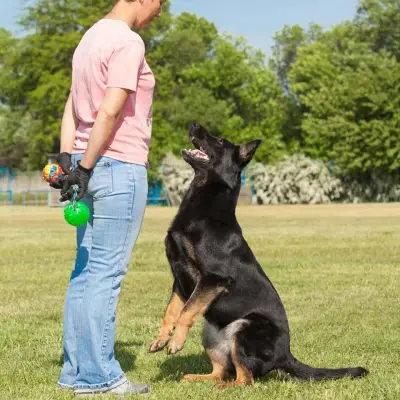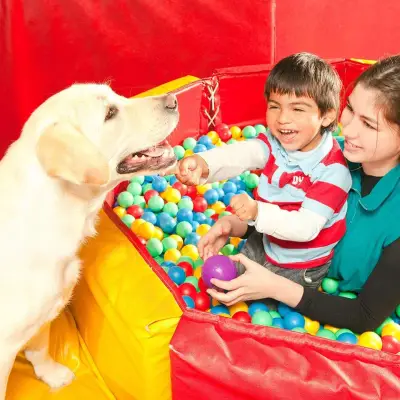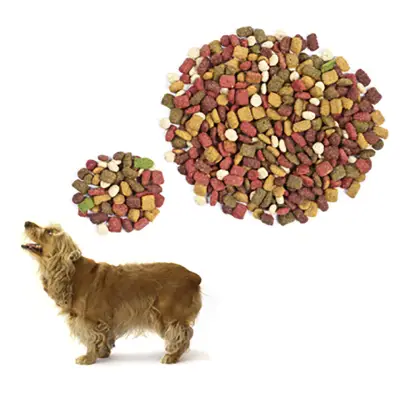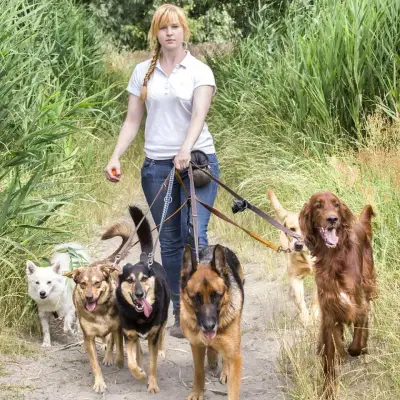If you’ve ever taken your dog for a walk only to find them tugging, chewing, or growling at their lead, it’s a situation many owners are all too familiar with. This behaviour is especially common during early training stages and can quickly turn what should be a peaceful walk into a bit of a battle.
Whether you’re trying to figure out how to stop a puppy from biting the leash or want to curb a long-standing habit in an older dog, it’s helpful to understand what’s behind the behaviour and how to stop it so you can enjoy calmer, more enjoyable walks with your four-legged friend.
Jump to:
Recommended for you!
Best SellersWhy Does My Dog Bite the Leash When Walking?
There are several reasons why a dog might bite or chew its lead, and understanding the cause is key to finding the right solution.
- Overexcitement: Dogs often associate the lead with going outside, one of the most exciting parts of their day. That excitement can boil over into grabbing or mouthing the lead as a form of play.
- Teething and Exploration: If your puppy is biting the leash and jumping or chewing it constantly, it could be due to teething. Puppies use their mouths to explore the world, and the lead just happens to be an easy target.
- Frustration or Lack of Control: Sometimes, leash biting is your dog’s way of expressing frustration. If they feel restricted or unable to explore where they want to go, they may resort to biting the thing that’s holding them back—the leash.
- Play and Attention-Seeking: Some dogs learn that biting the lead gets a reaction from their owner. Even if it’s not the reaction you want to give, it can reinforce the behaviour if your dog sees it as play or attention.
Is Dog Leash Biting a Problem?
You might be wondering whether leash biting is something to worry about. In small doses, it’s not uncommon, especially for younger dogs. But when it becomes a habit, it can cause:
- Safety concerns if the leash becomes damaged or frayed
- Behavioural issues that escalate into pulling or lunging
- Stress and frustration during walks
- Reinforced bad habits if not addressed properly
That’s why it’s helpful to learn how to stop a dog from biting the leash early on, before it becomes more difficult to manage.
How to Stop a Dog or Puppy from Biting the Leash: 17 Steps
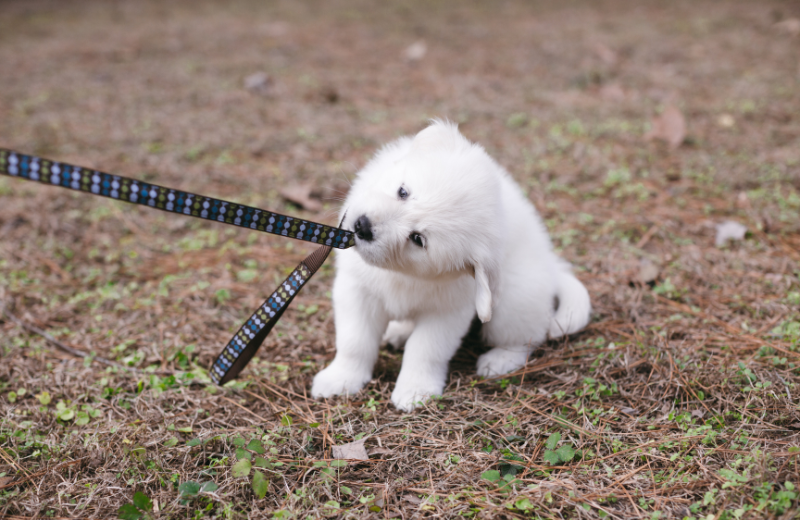
Whether your dog is young and teething or older and stuck in a habit, leash biting is common but fixable. The following tips offer practical solutions to help you manage and reduce the behaviour in a kind and consistent way.
1. Let Them Explore the Lead Indoors
Give your dog or puppy time to sniff, mouth, and interact with the lead at home in a relaxed setting. This makes the leash less exciting and helps prevent the biting from becoming part of a walk-time routine. Letting them explore it calmly helps take away the novelty and teaches them it’s not a toy.
2. Redirect with a Toy or Chew Item
Carry a tug toy, chew, or soft rope on your walk and offer it when your dog begins to bite the leash. This gives them a more appropriate outlet for their energy or teething needs and redirects their focus away from the lead. Choose a toy that’s only used on walks to make it feel extra rewarding.
3. Teach a “Leave It” or “Drop” Command
Practice cues like “leave it” and “drop” with treats in a quiet space at home, and then use them on walks. When your dog releases the lead, reward with praise or a high-value treat so they associate letting go with something positive. These cues give your dog a clear alternative action they can succeed at.
4. Keep Walks Calm and Manageable
Short, predictable walks with regular pauses and clear boundaries help prevent your dog from becoming overstimulated. Calm routines make it easier for your dog to learn polite lead behaviour. Ending walks before your dog becomes overly excited can reduce the chance of biting.
5. Avoid Tug-of-War with the Lead
If your dog starts pulling on the lead, don’t yank it back or engage in a struggle, as this turns it into a game and can make the behaviour worse. Simply stand still, wait patiently, and only resume walking once the lead is released. This teaches them that calmness brings progress.
6. Use a Chain Lead or Safe Deterrent
A lead with a metal section near the clip, or a dog-safe, bitter-tasting spray, can discourage chewing. Many dogs dislike the sensation or taste and will naturally stop mouthing the lead without any need for correction. Always introduce new equipment gently to keep your dog relaxed.
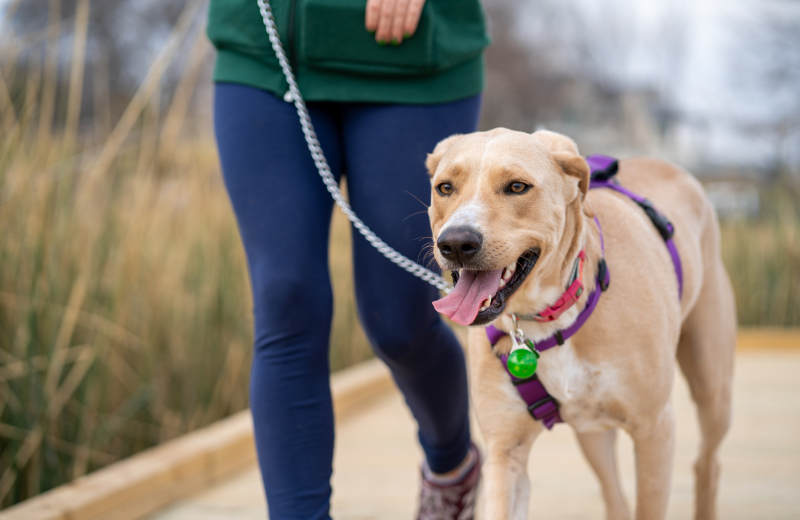
7. Vary and Enrich Your Walking Routine
Mix up your walking routes and include moments for sniffing, training cues, or play. This keeps walks engaging and helps prevent boredom-related leash biting. A mentally stimulated dog is far less likely to fixate on the lead.
8. Offer an Outlet for Energy
Dogs who are under-exercised or mentally understimulated are far more likely to act out on walks. Make sure your dog has opportunities to run, play, and explore throughout the day, not just when they’re on the lead. A tired dog is a calmer dog.
9. Practice Focus and Impulse Control
Dogs that bite the leash often struggle with impulse control, especially when overstimulated or distracted. Use simple games like “look at me,” “touch,” and “sit and wait” to help them focus on you and stay grounded during walks. These habits build calmness and teach self-control.
10. Use Training Breaks During the Walk
Include short, structured stops where your dog performs a basic command like “sit” or “stay” before continuing. These small tasks help shift their attention away from the lead and towards you. They also create mini check-in moments that reduce pulling and biting.
11. Stay Calm and Consistent
Avoid shouting, yanking, or showing frustration, even if the behaviour is repetitive. Calm, consistent handling builds trust and teaches your dog that biting the leash isn’t worth the effort. Your steady response sets the tone for their behaviour.
12. Reward Calm Behaviour Often
Catch your dog doing the right thing, like walking beside you without biting, and reward them. Positive reinforcement encourages them to repeat those calm behaviours in future walks. The more you praise what you like, the more you’ll see it.
13. Keep Toys Reserved for Walks
If you use a tug or chew toy as a redirection tool, keep it special by only offering it on walks. This increases its value and makes it more effective at distracting your dog from the lead. A “walk-only” toy gives your dog something to look forward to that’s not the leash.
14. Consider a Front-Clip Harness
Sometimes leash biting happens due to discomfort or tension caused by traditional collars or back-clip harnesses. A front-clip harness offers more control and can reduce frustration during walks. It also helps prevent pulling, which can trigger biting in some dogs.
15. Don’t Overdo the Distance
Especially with young puppies, long or overly busy walks can lead to sensory overload. Keeping walks short, familiar, and pleasant helps prevent bad habits like leash biting from developing. Gradually increase your dog's walk duration as they build confidence and focus.
16. Use High-Value Rewards
Not all treats are created equal. If your dog is particularly fixated on biting, bring out something extra tasty or exciting. A special reward can help motivate a faster change in behaviour. Try using their absolute favourite snack only for leash success.
17. Train Before the Walk Begins
Set the tone by asking for calm behaviour before the lead even goes on. Practice sit-and-wait at the door and only clip on the lead when your dog is settled. This creates a smoother transition into the walk itself. A calm start often leads to a calmer walk overall.
What to Avoid When Stopping Dog Leash Biting
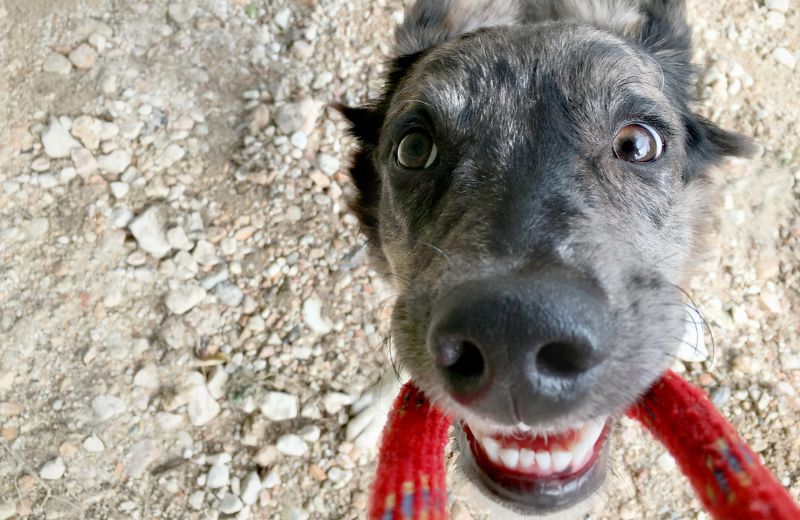
Sometimes good intentions can backfire. Here are a few things to avoid when trying to stop dog chewing lead or leash biting behaviours.
- Don’t use punishment or lead jerks, as this can increase anxiety or frustration
- Don’t make the behaviour into a game by reacting loudly or chasing the dog
- Avoid using the leash to control behaviour too much; dogs need mental stimulation and freedom to explore within safe boundaries
Consistency, calmness, and positive reinforcement are far more effective.
When Should You Seek Help?
If your dog shows signs of aggression, growling, or guarding the lead, or if the biting behaviour is intense and difficult to interrupt, it may be time to work with a qualified dog trainer or behaviourist. They can help you understand the underlying causes and provide a tailored plan.
Professional advice can be especially helpful if behaviour turns into jumping, pulling, or nipping at you during walks. If you’d like to gain expert-level insight yourself, our Dog Training Diploma Course, created by specialists in animal psychology, offers a fantastic opportunity to learn proven techniques and better understand your dog’s behaviour from the comfort of your own home.
Frequently Asked Questions
Can leash biting be a sign of anxiety?
In some cases, leash biting may stem from anxiety or nervous energy. Dogs that feel uncertain or overwhelmed on walks may express that tension by chewing the lead. If you suspect anxiety is the cause, try shorter, quieter walks and offer reassurance through a calm tone, gentle guidance, and routine. If you suspect your dog has anxiety and want to learn how to support them, our Canine Anxiety Diploma Course (just £29) is a great place to begin.
Is leash biting common during adolescence?
Just like teenagers, adolescent dogs go through a stage of testing boundaries and can display bursts of energy, frustration, and defiance. Leash biting often reappears during this stage, even if your puppy had previously stopped. Stay consistent with your training and continue to reinforce calm behaviour.
Should I completely ignore my dog when they bite the lead?
While you don’t want to give them attention that reinforces the behaviour, you also don’t want to ignore it completely if it continues. The best response is to pause calmly, disengage from the behaviour, and redirect your dog once they’ve settled. Reward the moment they stop biting.
Can I use a muzzle to stop leash biting?
A muzzle may prevent biting, but it doesn’t teach your dog an alternative behaviour or address the underlying cause. Muzzles should never be used as a long-term fix for behavioural issues like leash biting. Focus on training, redirection, and consistency first, and consult a professional if you’re struggling.
How long does it take to stop a dog from biting the leash?
It varies from dog to dog. Some will respond to training within a few days, while others, especially if the behaviour has been reinforced over time, may take weeks or more. Patience and repetition are key. Stick to your chosen strategies and celebrate small wins along the way.
Is leash biting more common in certain breeds?
Some high-energy or working breeds (like Border Collies, German Shepherds, or Boxers) may be more prone to leash biting simply because they have a stronger drive to engage with their environment. These dogs often benefit from added mental stimulation and structured tasks during walks.
Does the type of lead I use make a difference?
Leads made from soft, fabric-like material may be more tempting to chew. Switching to a rubber-coated, leather, or chain section near the clip may discourage biting. The right equipment can make training easier when used alongside consistent behavioural cues.
Can leash biting turn into aggression?
While leash biting usually starts as play or frustration, it can escalate if it’s not addressed, especially if the dog becomes overly aroused or stressed. If your dog growls, snaps, or guards the lead aggressively, consult a professional trainer or behaviourist to avoid further escalation.
Recommended for you!
Best SellersStudy Our Dog Training Diploma for £29
If you're ready to deepen your understanding and become a confident, knowledgeable trainer, consider taking the Dog Training Diploma Course with Centre of Excellence. Whether you're a dog owner, aspiring trainer, or simply passionate about canine behaviour, this course offers comprehensive guidance suitable for all levels. And right now, you can enrol for just £29.



